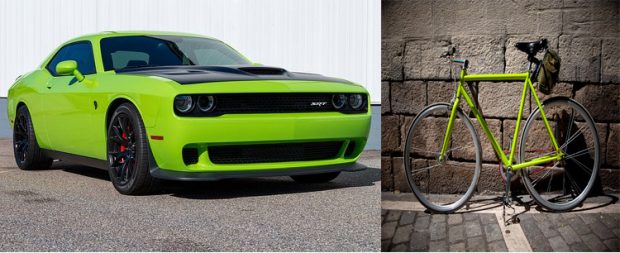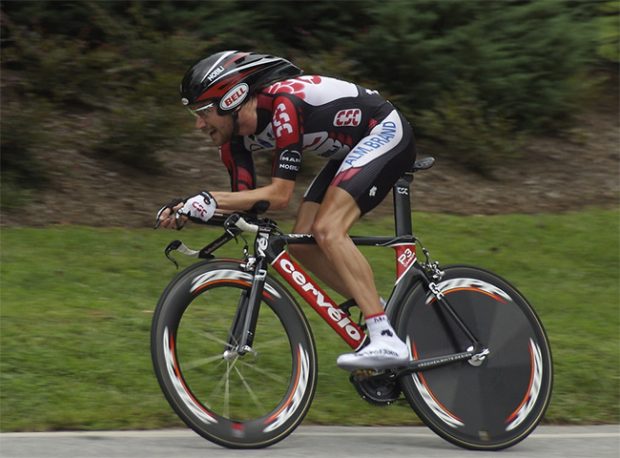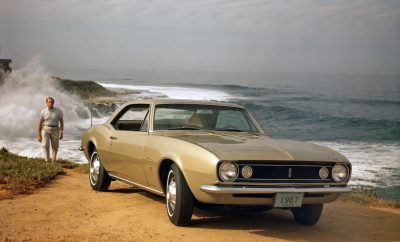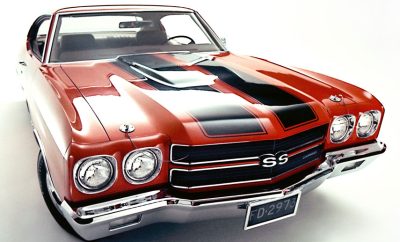Best Muscle Cars
The Muscle Car vs. Bicycle Debate

By Dave Ashton
The muscle car niche has always been a small part of the overall automotive world. However, the label is generally borrowed not just for thoroughbred American versions, but any large, high powered vehicle. The muscle car label can be then wielded as a generic anti-hero.
It’s not often the debate between muscle cars and bicycles becomes front of mind, but after reading the article, ‘The marginal uselessness of muscle cars’ on the reslience website, defence mode went into overdrive from a muscle car perspective. However, as we like to see ourselves as diplomatic types over here, we wanted to read the arguments and counter-arguments before drawing our own conclusions….
Bicycles are faster off the Line

The first premise of the argument is that bicycles are quicker off the line at an intersection. With the right gears selected on a bicycle and a well-timed set-off, the bicycle was faster from 1 – 20 km/h. In heavy city traffic, the bicycle appears the winner.
This isn’t headline news to any car driver. When a human being is stuck in any type of queueing system, they are generally slower than anyone allowed to go at their own pace. In heavy traffic, every car is in a queueing system and very conscious of not bumping into any car ahead of them. This means it’s very rare for someone to put the pedal to the metal in built-up traffic.
We could talk about the differences in power to weight ratios of both machines and the eco-and economic impacts. However, the average muscle car isn’t particularly designed for constant inner-city usage. How quickly it can hit 62mph or a quarter-mile is where it counts. It just also has the ability to drive in city traffic when they need to.
As the focus here is on inner-city transportation, it obviously makes sense to use a bicycle for commutable distances. The travelled distance is cheaper, pumps out less fumes (unless you ate a curry the night before) and can be quicker than a car depending on traffic. However, the argument only takes into account the individual.
The average car can usually transport up to four people. It’s also capable of carrying heavy loads, dropping the kids off, car sharing, keeping out the weather, and lots of other transportation uses. Travelling a few miles across the city to work makes sense with a bicycle. But if your place of work is 30 miles away from home, you have to drop the kids off in the morning, pick up the shopping, and drive through town, a bicycle doesn’t cover all bases.
The need for Speed
Many references in the article come from the book, Ivan Illich’s Energy and Equity. The message here seems to be that the constant need for evermore power and speed in transportation has shaped our way of thinking and how we live. Our towns and cities are designed for how cars move from A to B and are parked.
The message isn’t completely negative against cars, only above a certain power output. ‘If beyond a certain threshold transport obstructs traffic, the inverse is also true: below some level of speed, motorized vehicles can complement or improve traffic by permitting people to do things they could not do on foot or on a bicycle.’
Above 15 miles an hour, it seems the car becomes all-consuming, ‘The per capita wattage that is critical for social well-being lies within an order of magnitude which is far above the horsepower known to four-fifths of humanity and far below the power commanded by any Volkswagen driver.’ So, the message I got here was that cars aren’t bad per se, they are just overpowered and use too many resources.
If you only ever drive in city traffic, then a 20 hp engine would probably do the job. Therefore, the arguments against the ‘muscle car’ or more strictly cars as a whole, is concerned with city driving. Most would agree you wouldn’t buy a Dodge Challenger Hellcat for only a daily city commute. Just like you wouldn’t buy a Learjet to run the kids to school. It’s not built for that purpose.
Why Muscle Cars versus Bicycles?
An article that is highlighting how the need for speed chews up ever more resources, impacting the environment and all aspects of our social structure, it starts off with a need to beat a ‘muscle car’ off the line. Even for a cyclist, the human trait of wanting to be the first off the line is overwhelming.
Since the dawn of the automobile, it’s been a natural human tendency to push the boundaries and produce ever faster vehicles. However, once everyone was aware that we had gone past the tipping point of the numbers of cars on the road and the number of resources being used, these concerns become front of mind.
The average horsepower rating has gone up over the years, partly as we are sold the ideals of more power, but also because we all wanted it. Not to solely show off at an interchange, but to achieve our goals quicker and more efficiently. Muscle cars get the brunt of the argument as the ethos is large displacement engines, not exactly eco-friendly on the surface. You almost couldn’t label a better anti-hero to the bicycle. Probably why the original article was labelled, ‘The marginal uselessness of muscle cars’ rather than ‘The marginal uselessness of high-powered cars.’ The article is more about cars in general, but as it’s labelled up about muscle cars, we have to defend our honour in that respect.
Tools for the Job
If it was only that simple…
If I’ve read everything correctly, the takeaway message from the article is that most town and city commutes only need a low horsepower car or bicycle for most journeys. Also, if most people used a bicycle for inner-city commutes, we would benefit all-round economically, socially, with resources and even the design and planning of towns and cities.
However, even if the internal combustion engine went away tomorrow and was replaced wholly by EV vehicles, we would still want ever-faster modes of transport. These instruments of transportation are at their heart simply tools for us to use. It’s how they are used that count. Just as a small engined car or a topline muscle car can both be used to intimidate a cyclist on the road, a cyclist can also not adhere to road safety and be a hazard to car users. As it’s always humans using these devices, we are always chewing up resources somewhere along the line.
Muscle car is also a high ticket item and a high-performance machine. This means that only a small part of the population usually buys into these vehicles and they are used as a second car or sporadically. Therefore, with the number of muscle cars on the road, even in a completely EV and cycle led society they should be able to coexist.
Conclusion
It would be very easy to waffle on all day about the pros and cons of each mode of transport. All the exercise and environmental benefits of owning a bicycle, and all the power, usefulness, convenience, and adaptability of a high-powered car.
I think car and bicycle owners will never see eye to eye. It only takes one bad experience on either side to form a negative opinion. But that doesn’t mean each machine should be generalized for being inherently bad. Would muscle cars get the same bad viewpoint if they were all driven sedately and ran off completely eco-friendly fuels? Would cyclists be viewed differently if they all stuck to their designated cycle lanes?
The cost of a muscle car will always overshadow the price of a bicycle. They are costly in time and money, but also bring a sense of well-being and satisfaction which only comes with a high-powered car. With that much personal investment, they should be used as much as possible, even within a cityscape.
Then there is the option to have both. Own a bicycle for short commutes, then use the muscle car for special occasions. This is the mindset of the classic car owner. To cherish and maintain a piece of fine engineering, used once in a while. In other words, car ownership is more than a horsepower rating.
The lazy mindset of us against them is an easy one to make. Buying a bicycle and getting rid of your car, automatically enters you into an exclusive club and vice versa. You are now free from the shackles of the consumerist automobile, saving money and the environment while also getting fitter. The average car owner enjoys the convenience of going anywhere, any time, generally in luxury, and hates those cyclists bobbing and weaving throughout traffic.
One group won’t ever fully understand the other unless they own and use both on a regular basis. Some do, but the tendency to be in only one camp or the other is the norm. So, as always it’s down to the user and how we use these machines that count.









0 comments